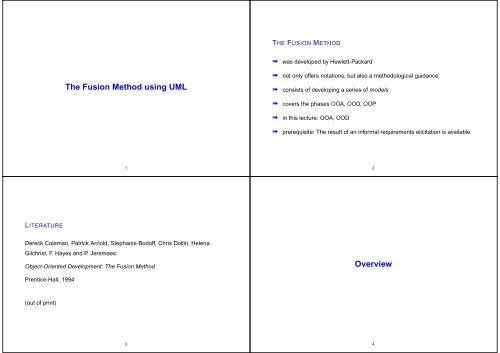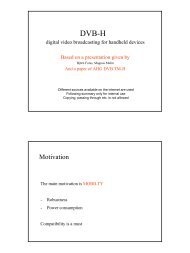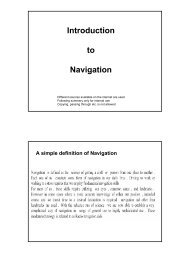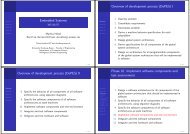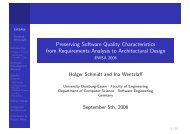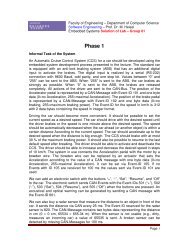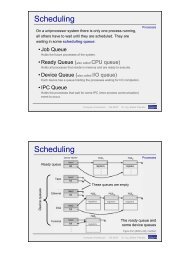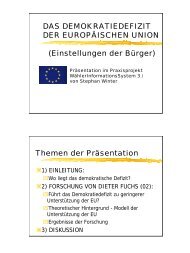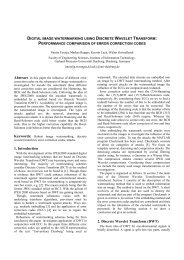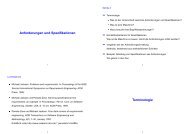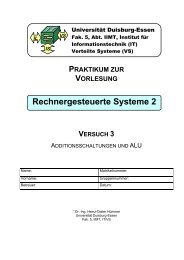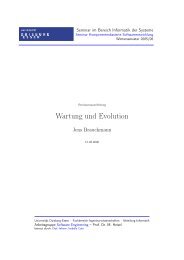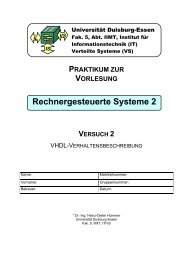Slides Part 2 (OOA, pages 1-128, pdf, 4 slides per page)
Slides Part 2 (OOA, pages 1-128, pdf, 4 slides per page)
Slides Part 2 (OOA, pages 1-128, pdf, 4 slides per page)
You also want an ePaper? Increase the reach of your titles
YUMPU automatically turns print PDFs into web optimized ePapers that Google loves.
LITERATURE<br />
The Fusion Method using UML<br />
Dereck Coleman, Patrick Arnold, Stephanie Bodoff, Chris Dollin, Helena<br />
Gilchrist, F. Hayes and P. Jeremaes:<br />
Object-Oriented Development: The Fusion Method<br />
Prentice-Hall, 1994<br />
(out of print)<br />
1<br />
3<br />
THE FUSION METHOD<br />
➠ was developed by Hewlett-Packard<br />
➠ not only offers notations, but also a methodological guidance<br />
➠ consists of developing a series of models<br />
➠ covers the phases <strong>OOA</strong>, OOD, OOP<br />
➠ in this lecture: <strong>OOA</strong>, OOD<br />
➠ prerequisite: The result of an informal requirements elicitation is available<br />
2<br />
Overview<br />
4
ANALYSIS<br />
➠ Goal: Comprehension and description of the visible system behavior within<br />
the application context.<br />
➠ Implementation considerations are not into account.<br />
➠ Models of analysis:<br />
• class model: displays the application context; relations between classes<br />
• system o<strong>per</strong>ations<br />
• <strong>per</strong>mitted sequences of system o<strong>per</strong>ations<br />
Note: Classes in the Fusion analysis phase have no o<strong>per</strong>ations (yet)!<br />
5<br />
The Fusion Analysis Process<br />
7<br />
DESIGN, IMPLEMENTATION<br />
➠ Design:<br />
• Goal: abstract implementation concept<br />
• System o<strong>per</strong>ations are represented by the runtime behavior of<br />
interacting objects<br />
➠ Implementation:<br />
• Transforms design models into an executable code<br />
• system class model ❀ classes of the programming language<br />
• object interactions ❀ method calls<br />
• Permitted sequences ❀ control structures<br />
Simultaneously: data dictionary, consistency checks<br />
Starting point: Description of facts and requirements using natural language.<br />
Multiple steps, in each of which a model is developed.<br />
1. Class model<br />
Describes objects and concepts of the problem environment<br />
2. Use case model<br />
Coarse-grained functionality of the system<br />
3. Scenarios<br />
Refinement of the use case model<br />
Identification of system o<strong>per</strong>ations<br />
4. O<strong>per</strong>ation model<br />
Specification of the system o<strong>per</strong>ations as relations between the “before”<br />
and “after” states<br />
6<br />
8
5. System class model<br />
Borderline between system and environment<br />
Refinement of the class model<br />
6. Life-Cycle model<br />
Global system behavior<br />
Behavior of objects<br />
DATA DICTIONARY<br />
Contains all used names; representation as a table:<br />
Name Kind Description Source<br />
Name of the<br />
element<br />
Class, system o<strong>per</strong>ation,<br />
attribute,<br />
etc.<br />
9<br />
Short informal<br />
description<br />
Must be maintained throughout the entire development process!<br />
11<br />
All models that contain<br />
the name<br />
➠ Static aspects of the system: Class model<br />
➠ Dynamic aspects of the system: Interface model<br />
consisting of<br />
• Use cases<br />
• Scenarios<br />
• O<strong>per</strong>ation model<br />
• Life-Cycle model<br />
EXAMPLE<br />
Name Kind Description Source<br />
account.number attribute Unique account number<br />
of an account.<br />
Bank class A bank consists of a<br />
number of accounts<br />
open account system<br />
o<strong>per</strong>ation<br />
Transaction life-cycle<br />
expression<br />
10<br />
A customer opens an account<br />
at a bank<br />
A transaction is either an<br />
deposit, a withdrawal, or<br />
a balance query.<br />
class model<br />
class model,<br />
system<br />
model<br />
class<br />
scenario, o<strong>per</strong>ation<br />
model<br />
life-cycle model
ASSOCIATIONS<br />
The class model<br />
➠ denote the relations between objects<br />
➠ are drawn as links between classes<br />
➠ can have an arity of more than two<br />
➠ can have names (convention: use capital letters)<br />
➠ can have multiplicities<br />
➠ can have role names<br />
13<br />
15<br />
MODELING THE STATIC ASPECTS OF THE APPLICATION CONTEXT<br />
Different notations for classes:<br />
or or<br />
Class Class Class<br />
a1: T1<br />
a2 : T2<br />
a1: T1<br />
a2 : T2<br />
op1(p: T1) : T2<br />
Classes in the Fusion analysis phase only have basic attributes (i. e., no<br />
object attributes) and no o<strong>per</strong>ations!<br />
EXAMPLE<br />
Professor Institute<br />
1 Leads 0..1<br />
name<br />
name<br />
specialty<br />
director<br />
0..2<br />
Gives<br />
*<br />
Course<br />
title<br />
4..6 Takes 3..*<br />
Student<br />
name<br />
participant inscription_number<br />
14<br />
role<br />
association name<br />
mulitplicity reading direction<br />
16
MEANING OF THE CLASS DIAGRAM<br />
➠ Each institute has exactly one professor who leads it.<br />
➠ This professor is called ”director”.<br />
➠ A professor leads at most one institute.<br />
➠ A professor can give course, but need not do so.<br />
➠ Each course is given by at most two professors (also zero professors are<br />
possible).<br />
➠ A student takes four to six courses.<br />
➠ There, he is a “participant”.<br />
➠ A course has to be taken by at least three students.<br />
ROLE NAMES<br />
➠ are written at the ends of the links<br />
➠ <strong>per</strong> convention, role names are written in small letters<br />
Person<br />
1..*<br />
child<br />
17<br />
IsChildOf<br />
19<br />
parent<br />
2<br />
ASSOCIATIONS WITH ARITY GREATER THAN TWO<br />
Associations can exist between more than two classes.<br />
MULTIPLICITIES<br />
Student Exam<br />
Room<br />
Writes<br />
➠ express cardinality constraints of relations<br />
18<br />
➠ for each object o of Class2, there exist m objects o ′ of Class1, such that o<br />
and o ′ are in relation Rel.<br />
Notation:<br />
Class1<br />
Rel<br />
Class2<br />
m<br />
• number n: exactly n objects<br />
• scope i..j<br />
• * : any number, also 0<br />
• i..∗ : at least i<br />
• ∗..j : at most j<br />
• not specified : means *<br />
• 0..1, 3..4, 6..∗ :<br />
20<br />
all quantities except 2 and 5
ASSOCIATION CLASSES<br />
➠ Associations can also have attributes.<br />
➠ Reasonable, if the attributes cannot be assigned to any of the classes<br />
involved in the association.<br />
Writes<br />
Student Exam<br />
Writes<br />
mark<br />
GENERALIZATION/SPECIALIZATION<br />
➠ Classes correspond to types.<br />
➠ Subclasses correspond to subtypes, not subsets.<br />
➠ Specialization = ”is a” , but ”act as” , ”is a kind of”<br />
BachelorCourse MasterCourse<br />
subject<br />
21<br />
Course Personnel Student<br />
Constraint<br />
title<br />
name<br />
name<br />
<strong>per</strong>s.nr<br />
inscription_number<br />
salary<br />
{complete}<br />
specialization<br />
23<br />
Professor TeachingAssistent<br />
specialty<br />
AGGREGATION AND COMPOSITION<br />
are special associations.<br />
Room<br />
Wall<br />
The wall is a part of the room.<br />
If a part belongs to only one whole and can only exist with that whole, then this<br />
is a composition relation.<br />
CONSTRAINTS<br />
Window<br />
Frame<br />
or<br />
➠ Are conditions that must hold.<br />
➠ Are written between “{}”.<br />
22<br />
Window<br />
Frame<br />
➠ The example: “{complete}” means that no other subclasses of Course<br />
can exist.<br />
➠ Meaning of constraints must be described informally.<br />
24
STRUCTURING CLASS MODELS<br />
In general the class model must divided into different diagrams. The following<br />
conventions must be obeyed:<br />
➠ Modeling elements with the same name represent the same element.<br />
➠ The set of the attributes of an element is the union of the attributes of all<br />
element representations.<br />
➠ Multiplicities are combined by conjunction, i.e., 1..14 and 0..5 yields 1..5.<br />
➠ Role names must be unique.<br />
25<br />
• The contents of an already placed contract only changes if the client<br />
wishes for changes and the central office approves of these changes. A<br />
client contacts an employee of the agency and informs the employee about<br />
the desired changes. The employee notifies the central office about the<br />
change request. The central office then decides on accepting the request<br />
or not and making changes if necessary.<br />
The procedure for canceling contracts proceeds analogously.<br />
• The data concerning product changes and launches is adjusted monthly.<br />
Here, the central office updates the databases of the agencies for each<br />
product.<br />
27<br />
EXAMPLE: INSURANCE AGENCY<br />
A software system is to be developed for managing an insurance agency.<br />
• The following products are offered: Health insurance- (HI), automobile<br />
liability- (AL) and private liability (PL).<br />
• An employee prepares offers for individual products. These offers contain<br />
the essential data for the respective insurance. The product information<br />
must be available in form of a database. Client data must be entered if they<br />
are not yet present.<br />
• The employee prepares the application together with the client. The<br />
application is sent from the agency to the central office. The central office<br />
checks the application and records the data in its system. If a contract can<br />
be placed, the central office sends this contract to the agency in electronic<br />
form. A newly placed contract can only refer to a current product.<br />
26<br />
• In case of an occurrence of event insured, the client has to contact an<br />
employee of the agency. In case of AL and PL insured events, the agency<br />
authorizes an ex<strong>per</strong>t advisor who appraises the damage and sends the<br />
corresponding report back to the agency via Internet. In insured events<br />
within the scope of HI, no ex<strong>per</strong>t advisor is appointed. The central office<br />
can decide on assuming the payment for an insured event or not. In cases<br />
of AL and PL, the agency determines the settlement of a claim on the<br />
basis of the ex<strong>per</strong>t advisor’s report.<br />
28
PreparesAppl<br />
CLASS MODEL FOR THE INSURANCE AGENCY<br />
Client<br />
clientData<br />
Employee<br />
Application<br />
Checks<br />
CentralOffice<br />
ForAppl<br />
Updates<br />
1<br />
PreparesOffer<br />
Settles<br />
1<br />
Offer<br />
offerData<br />
Product<br />
productData<br />
HI AL PL<br />
Approves<br />
1<br />
WorksFor<br />
ForOffer<br />
1<br />
Decides_onHI<br />
RefersTo<br />
29<br />
Contract<br />
ContractData<br />
Agency<br />
InsuredEvent<br />
Concerning<br />
The Use case model<br />
31<br />
Authorizes<br />
Ex<strong>per</strong>tAdvisor<br />
HI−Event<br />
Report<br />
AL/PL−Event<br />
DecidesOn<br />
Prepares<br />
OBJECT-ORIENTED ANALYSIS<br />
➠ Class model =⇒ Static aspects<br />
➠ Interface model =⇒ Dynamic aspects<br />
AIM<br />
• Use case model<br />
• Scenarios<br />
• O<strong>per</strong>ation model<br />
• System class model<br />
• Life-Cycle model<br />
➠ Coarse-grained view of the system.<br />
➠ Identification of function groups.<br />
PROCEDURE<br />
➠ Identify actors<br />
➠ Identify use cases<br />
➠ Identify associations between actors and use cases<br />
30<br />
32
ACTORS<br />
➠ are outside of the system<br />
➠ represent different user roles<br />
➠ can be either human beings or other systems<br />
➠ should appear in the class model<br />
➠ corresponding classes are not implemented<br />
➠ Notation:<br />
BankClerk<br />
DESCRIPTION OF SEQUENCES OF ACTIONS<br />
➠ necessary, because ovals do not convey any semantics<br />
➠ verbally or with scenarios, which are represented as diagrams<br />
➠ Distinction of<br />
• Normal cases (main flow of events)<br />
• Error cases (exceptional flow of events)<br />
33<br />
35<br />
USE CASES<br />
➠ are sets of sequences of actions<br />
➠ must have a name<br />
➠ describe the interaction between actors and the system<br />
➠ Criteria:<br />
The system supplies an observable result which is of use for the actor.<br />
➠ Notation:<br />
Process<br />
Loan<br />
EXAMPLE: USE CASE ”‘AUTHENTICATE USER”’<br />
➠ Normal case:<br />
1. System asks user for PIN<br />
2. User enters PIN<br />
3. System checks correctness<br />
➠ Exceptional cases:<br />
• User enters wrong PIN 3 times<br />
• User aborts transaction<br />
• User mistyped, presses CLEAR-Button<br />
34<br />
36
Use case diagrams<br />
COMMON BEHAVIOR CAN FACTORED OUT<br />
➠ include-relation<br />
A use case explicitly contains another. The latter does not appear on its<br />
own, instead it serves to avoid repetitions.<br />
Place<br />
Order<br />
37<br />
dependency<br />
<br />
Authenticate<br />
User<br />
39<br />
stereotype<br />
GENERALIZATION-/SPECIALIZATION RELATIONS<br />
are possible for actors as well as use cases:<br />
CommercialCustomer<br />
Customer<br />
Check<br />
Password<br />
Authenticate<br />
User<br />
Scan<br />
Retina<br />
UML 2.0: Use cases may have attributes and o<strong>per</strong>ations, and behavior may be<br />
specified with state machines.<br />
NEW LANGUAGE ELEMENTS<br />
➠ Dependency: --------><br />
38<br />
Change in independent things (at the arrow head) causes a change in<br />
dependent things.<br />
e.g. change in PlaceOrder when AuthenticateUser changes.<br />
➠ Stereotypes: ><br />
• Extension of UML by new basic elements.<br />
• describes the above mentioned-dependency between<br />
use cases.<br />
• When verbally describing PlaceOrder, then AuthenticateUser must also<br />
be described.<br />
• There is an additional dependency with a predefined stereotype,<br />
namely .<br />
40
➠ extend-relation<br />
extension points:<br />
RushOrder<br />
PlaceOrder<br />
<br />
Place<br />
Rush<br />
Order<br />
Condition: {rushOrderCond}<br />
extension point: RushOrder<br />
• Base use case can appear on its own, but in some cases its behavior is<br />
extended through another use case.<br />
• This expresses optional system behavior.<br />
• Sequence of actions: If condition is satisfied at extension point, then<br />
optional behavior is executed.<br />
• Note: Here the dependency is the other way around than with<br />
! The optional behavior depends on the basic behavior!<br />
ANOTHER EXAMPLE<br />
BankClerk<br />
LoanEx<strong>per</strong>t<br />
extension points:<br />
NC<br />
OpenAccount<br />
Close<br />
Account<br />
Process<br />
Transaction<br />
extension points:<br />
NC<br />
ProcessLoan<br />
41<br />
Condition: {NewClient}<br />
extension point: NC<br />
<br />
<br />
Schufa−<br />
Query<br />
Bank<br />
Schufa<br />
Note: Loan ex<strong>per</strong>ts are allowed to open accounts while ”‘regular”’ employees<br />
are not allowed to process loans.<br />
43<br />
LAST STEP<br />
• Use associations for connecting the actors with the use cases.<br />
• Draw system boundaries.<br />
Example: Cellular telephone<br />
CellularNetwork<br />
User<br />
extension points:<br />
CC<br />
PlacePhoneCall<br />
Place<br />
Conference−<br />
call<br />
Condition: {CCButtonPressed}<br />
extension point: CC<br />
extension points:<br />
RAC<br />
<br />
ReceivePhoneCall<br />
Condition: {AddCallArr}<br />
extension point: RAC<br />
Use<br />
Scheduler<br />
42<br />
Receive<br />
additional<br />
call<br />
Cellular Telephone<br />
USE CASE MODEL FOR THE INSURANCE AGENCY<br />
Employee<br />
extension points:<br />
CD<br />
Prepare<br />
offer<br />
extension points:<br />
CD<br />
Prepare Application/Contract<br />
Update<br />
Products<br />
Change/<br />
cancel<br />
contract<br />
Treat<br />
ensured<br />
event<br />
<br />
<br />
Treat<br />
HI ensured<br />
event<br />
Treat<br />
AL/PL ensured<br />
event<br />
44<br />
Enter<br />
Client<br />
Data<br />
Condition: {NoClientData}<br />
extension point: CD<br />
<br />
Authorize<br />
report<br />
Agency<br />
CentralOffice<br />
Ex<strong>per</strong>tAdvisor
Next step: Describing sequences of actions<br />
SCENARIOS<br />
➠ Describe all sequences of actions contained in the use cases.<br />
➠ Describe communication flows between the system and its environment.<br />
45<br />
➠ <strong>Part</strong>icipants: System as well as actors according to the use case diagram.<br />
➠ Notation: UML 2.0 sequence diagrams.<br />
➠ At least one scenario must exist for each use case!<br />
➠ Each scenario describes one possible flow of events (normal case or<br />
exceptional case).<br />
47<br />
OBJECT-ORIENTED ANALYSIS<br />
➠ Class model =⇒ Static aspects<br />
➠ Interface model =⇒ Dynamic aspects<br />
• Use case model<br />
• Scenarios<br />
• O<strong>per</strong>ations model<br />
• System class model<br />
• Life-Cycle model<br />
MODELING ALTERNATIVES<br />
➠ Define one scenario for each normal case and each exceptional case<br />
+ simple scenarios<br />
- repetitions<br />
➠ Use combined fragments to define scenarios<br />
+ exploit include- and extend-relations from use case model<br />
- scenarios become more complex<br />
- no indeterminism; conditions have to be given<br />
46<br />
48
EXAMPLE: OPENING AN ACCOUNT<br />
• Normal case 1: A new customer wants to open an account. A Schufa query<br />
is necessary. Schufa confirms credit-worthiness, the account is opened.<br />
• Exceptional case 1: A new customer wants to open an account. Schufa<br />
query is negative. Account-opening is rejected.<br />
• Exceptional case 2: A customer wants to open an account as new<br />
customer. This customer is however already known as customer.<br />
• Normal case 2: A customer wants to open another account.<br />
Credit-worthiness is checked in-house. Credit-worthiness is good, account<br />
is opened.<br />
• Exceptional case 3: A customer wants to open another account.<br />
Credit-worthiness is checked in-house. Credit-worthiness is negative,<br />
account-opening rejected.<br />
NOTE:<br />
➠ System o<strong>per</strong>ations are arrows from an actor to the system.<br />
➠ We use asynchronous messages to model system o<strong>per</strong>ations (UML2.0<br />
also allows synchronous and reply messages).<br />
➠ Output events are arrows from the system to an actor.<br />
➠ Parameters are not yet specified.<br />
49<br />
➠ Each scenario has to start with a system o<strong>per</strong>ation (i. e., the system does<br />
not initiate anything)<br />
➠ Not all system o<strong>per</strong>ations have associated output events.<br />
➠ In general, a scenario may contain several actors, system o<strong>per</strong>ations and<br />
output events.<br />
➠ The output is not necessarily sent to the actor who calls the system<br />
o<strong>per</strong>ation.<br />
51<br />
SIMPLE SCENARIOS: NORMAL CASE 1<br />
sd OpenAccountN1<br />
BankClerk<br />
open_new_customer_account<br />
account_opened<br />
name<br />
system (object) (not underlined)<br />
: Bank<br />
schufa_query<br />
credit_worthiness_ok<br />
50<br />
Schufa<br />
output event<br />
SIMPLE SCENARIOS: EXCEPTIONAL CASES 1 AND 2<br />
sd OpenAcccountE1<br />
system o<strong>per</strong>ation<br />
lifeline<br />
actor<br />
(asynchronous message)<br />
Scenario for exceptional case 1: Scenario for exceptional case 2:<br />
BankClerk<br />
account_not_opened<br />
sd OpenAcccountE2<br />
: Bank : Bank<br />
Schufa BankClerk<br />
open_new_customer_account open_new_customer_account<br />
schufa_query<br />
credit_worthiness_not_ok<br />
52<br />
customer_already_known
SIMPLE SCENARIOS: NORMAL CASE 2 AND EXCEPTIONAL CASE 3<br />
Scenario for normal case 2:<br />
sd OpenAcccountN2<br />
sd OpenAcccountE3<br />
: Bank<br />
BankClerk BankClerk<br />
account_opened<br />
Szenario for exceptional case 3:<br />
open_known_customer_accout open_known_customer_accout<br />
ignore to define messages to be ignored in the execu<br />
loop repetition<br />
neg to define forbidden behavior<br />
53<br />
account_not_opened<br />
par parallel independent execution of several o<strong>per</strong>ands tion<br />
seq weak sequencing (default)<br />
strict strict sequencing<br />
We will only use alt and opt.<br />
Moreover: ref: Reference to another sequence diagram.<br />
Avoids repetitions; semantics: replace reference by its contents.<br />
55<br />
: Bank<br />
COMBINED FRAGMENTS<br />
O<strong>per</strong>ators for combining different sequence diagrams. The following o<strong>per</strong>ators<br />
are defined:<br />
alt alternatives; more than two alternatives are possible.<br />
opt option<br />
assert assertion, to define a message sequence that must occur<br />
break description of behavior expected after a break<br />
coregion messages can be received in any order<br />
consider to define messages to be considered in the execution; equivalent to<br />
defining every other message to be ignored<br />
critical critical region<br />
PATTERN FOR MODELING “”<br />
sd UC1_i<br />
54<br />
<br />
UC1 UC2<br />
:X :Y<br />
ref<br />
M1<br />
M2<br />
M3<br />
M4<br />
UC2<br />
56
PATTERN FOR MODELING “”<br />
REMARKS<br />
extension points:<br />
EXT<br />
UC1<br />
sd UC1_i<br />
:X :Y<br />
opt<br />
[U2_Cond]<br />
<br />
M1<br />
M2<br />
➠ Nested combined fragments are possible.<br />
Op1<br />
Op2<br />
EXT<br />
M3<br />
M4<br />
57<br />
UC2<br />
Condition: {U2_Cond}<br />
extension point: EXT<br />
Condition or<br />
Continution<br />
Secnario ofr UC2<br />
➠ In this example, we did not use the pattern for “”, because<br />
we had to make a more general case distinction (customer already known<br />
or not).<br />
➠ Conditions have to be given for the alt and opt o<strong>per</strong>ators.<br />
59<br />
COMBINED FRAGMENTS: NORMAL CASE 1, EXCEPT. CASES 1, 2<br />
sd OpenAccountS1<br />
: Bank<br />
BankClerk Schufa<br />
open_new_customer_account<br />
alt<br />
[ClientKnown]<br />
customer_already_known<br />
[else]<br />
alt<br />
[queryOK]<br />
[else]<br />
account_opened<br />
account_not_opened<br />
REFERENCED SCENARIO<br />
sd SchufaQuery<br />
alt<br />
[creditWorthinessOK]<br />
[else]<br />
: Bank<br />
ref<br />
58<br />
schufa_query<br />
SchufaQuery<br />
credit_worthiness_ok<br />
credit_worthiness_not_ok<br />
60<br />
Schufa
METHOD<br />
➠ Consider all use cases given in the use case diagram.<br />
➠ For each use case:<br />
• Enumerate all normal and exceptional cases.<br />
• Set up a simple scenario for each case, or use combined fragments to<br />
cover several cases.<br />
➠ Collect the names of all arrows from an actor to system. These are the<br />
system o<strong>per</strong>ations which have to be specified in the following.<br />
USE CASE “PREPARE OFFER”, SIMPLE SCENARIOS<br />
sd PrepareOfferN1 sd PrepareOfferN2<br />
Employee<br />
c_data_present?<br />
c_data_present!<br />
prepare_offer<br />
offer_prepared<br />
61<br />
: Agency : Agency<br />
63<br />
Employee<br />
c_data_present?<br />
c_data_not_present!<br />
enter_c_data<br />
c_data_entered<br />
prepare_offer<br />
offer_prepared<br />
Scenarios for the insurance agency<br />
USE CASE “PREPARE OFFER”, COMBINED FRAGMENTS<br />
sd PrepareOffer<br />
Employee<br />
62<br />
c_data_present?<br />
alt<br />
[cdp] c_data_present!<br />
[else]<br />
c_data_not_present!<br />
enter_c_data<br />
c_data_entered<br />
prepare_offer<br />
offer_prepared<br />
64<br />
: Agency
OBJECT-ORIENTED ANALYSIS<br />
➠ Class model =⇒ Static aspects<br />
➠ Interface model =⇒ Dynamic aspects<br />
AIM<br />
• Use case model<br />
• Scenarios<br />
• O<strong>per</strong>ation model<br />
• System class model<br />
• Life-Cycle model<br />
➠ Descriptive specification of exactly the identified system o<strong>per</strong>ations<br />
➠ Specification of the state changes and generated output events<br />
➠ No programming, no behavior inside the system.<br />
➠ An o<strong>per</strong>ation schema must be specified for each system o<strong>per</strong>ation.<br />
➠ O<strong>per</strong>ation model = set of o<strong>per</strong>ation schemas<br />
65<br />
67<br />
The o<strong>per</strong>ation model<br />
EACH OPERATION SCHEMA CONTAINS<br />
➠ Name of the system o<strong>per</strong>ation<br />
➠ Informal description<br />
➠ Input/Output, communication with environment<br />
66<br />
➠ Assumptions on the state of the system before execution of the o<strong>per</strong>ation.<br />
➠ State change (effect) achieved by the o<strong>per</strong>ation.<br />
68
FUSION NOTATION<br />
O<strong>per</strong>ation = 〈Name〉<br />
Description = 〈Informal description〉<br />
Reads = 〈Input〉<br />
Changes = 〈Objects/Attributes/Associations, that might be changed 〉<br />
Sends = 〈Output events〉<br />
Pre = 〈Precondition〉<br />
Post = 〈Postcondition〉<br />
Sends Events that can be but do not have to be created.<br />
Must contain all output events occurring in the scenarios.<br />
Receiving actor is stated, e.g.<br />
Employee: {give money(amount), no cover}<br />
69<br />
Pre refers to the system state before calling the system o<strong>per</strong>ation and the<br />
supplied values.<br />
The effect of system o<strong>per</strong>ation as given by postcondition is only specified if<br />
the precondition is fulfilled.<br />
The precondition should be established by the sequences of events<br />
specified in the scenarios and in the life-cycle model.<br />
71<br />
COMPONENTS OF AN OPERATION SCHEMA<br />
Reads Objects/Attributes/Associations, whose state or value can be read but<br />
not changed.<br />
Keyword supplied for arguments that are from an actor (from exterior)<br />
Inputs that are not ”‘supplied”’ come from the internal state.<br />
Changes The concerned values can be read as well as changed but need not<br />
be changed.<br />
Keyword new for objects that are created by the system o<strong>per</strong>ation.<br />
Keyword delete for objects that are deleted by the system o<strong>per</strong>ation.<br />
Reads and Changes clauses must be disjoint!<br />
Post Relation (expressed as predicate) between pre-state and inputs on the<br />
one hand and post-state and outputs on the other hand.<br />
Variables of the post-state are decorated with ”‘ ′ ”’.<br />
70<br />
Predicate is sent{event} describes that event is sent to the actor given in<br />
the sends-clause as an effect of the system o<strong>per</strong>ation.<br />
No program! Only the effect is specified but not how it is achieved!!!<br />
72
Excursion: Design by Contract<br />
What are preconditions and postconditions good<br />
EXAMPLE<br />
I want to travel from Berlin to Duisburg.<br />
for?<br />
Commitments Advantages<br />
Passenger Pay ticket getting to Duisburg<br />
Traffic<br />
provider<br />
73<br />
Be there at departure time<br />
must keep precondition Has advantages from the postcondition<br />
Must take the passenger to<br />
Duisburg<br />
receives the price for the ticket;<br />
does not have to take passengers<br />
who have not paid or did not arrive<br />
in time<br />
Must guarantee postcond. Can assume precondition<br />
75<br />
SOURCE<br />
Bertrand Meyer<br />
Object-Oriented Software Construction<br />
Prentice Hall 1988 (1. Aufl.), 1997 (2. Aufl.)<br />
online see:<br />
http://archive.eiffel.com/doc/manuals/technology/contract/<strong>page</strong>.html<br />
CONTRACTS IN DAILY LIFE<br />
➠ Contractual partners are clients and sellers or service providers.<br />
➠ Both expect advantages from the contract and are willing to make a<br />
commitment.<br />
ADVANTAGES OF EXPLICIT CONTRACTS<br />
Meyer:<br />
74<br />
A contract document protects both the client, by specifying how much<br />
should be done, and the supplier, by stating that the supplier is not<br />
liable for failing to carry out tasks outside of the specified scope.<br />
APPLICATION TO SOFTWARE<br />
A contract is a formal agreement between a system / a class and its actors /<br />
clients. It specifies the rights and duties for both sides.<br />
76
EXAMPLE: STACK (GENERIC CLASS)<br />
class Stack[T]<br />
attribute nb elements: integer<br />
method empty(): Boolean<br />
full(): Boolean<br />
push(x: T)<br />
pop()<br />
top(): T<br />
end class Stack[T]<br />
pop()<br />
pre not empty<br />
post not full and nb elements’ = nb elements - 1<br />
and ”‘top element of the stack is deleted ”’<br />
top(): T<br />
pre not empty<br />
post noChange and Result = ”‘top element of the stack”’<br />
77<br />
79<br />
SPECIFICATION OF THE STACK OPERATIONS WITH<br />
PRECONDITIONS AND POSTCONDITIONS<br />
empty()<br />
full()<br />
pre true<br />
post Result = true ⇔ nb elements = 0<br />
pre true<br />
post Result = true ⇔ nb elements = . . .<br />
push(x: T)<br />
pre not full<br />
post not empty and nb elements’ = nb elements + 1<br />
and ”‘x is the new top element of the stack”‘<br />
COMMITMENTS AND ADVANTAGES<br />
Commitments Advantages<br />
Client Call push(x) only if stack is<br />
not full<br />
78<br />
Element x is put on stack, top() results<br />
in x, nb elements increases<br />
by 1.<br />
Must keep precondition has advantages from postcondition<br />
Server Makes sure that x is placed<br />
on the stack<br />
Must guarantee postcondition<br />
80<br />
Unnecessary to handle the case if<br />
stack is full.<br />
Can assume precondition
APPLICATION OF THE DESIGN-BY-CONTRACT-PRINCIPLE<br />
➠ Fusion <strong>OOA</strong>: Specifies system o<strong>per</strong>ations by means of preconditions and<br />
postconditions.<br />
➠ Fusion OOD: Specifies all added o<strong>per</strong>ations by means of preconditions<br />
and postconditions.<br />
➠ OOI: Give preconditions and postconditions as documentation in the<br />
source code.<br />
➠ There are programming languages (e. g. Eiffel) which allow for dynamic<br />
checking of preconditions and postconditions.<br />
CLASS MODEL FOR BANK<br />
Schufa<br />
Bank<br />
81<br />
Queries<br />
Owns<br />
Customer Account<br />
Checking<br />
Keeps<br />
Works_for<br />
Savings Credit<br />
83<br />
BankClerk<br />
LoanEx<strong>per</strong>t<br />
EXAMPLE: WITHDRAW MONEY FROM BANK ACCOUNT<br />
sd WithdrawN<br />
sd<br />
: Bank<br />
WithdrawE<br />
BankClerk BankClerk<br />
withdraw_money<br />
withdraw_money<br />
give_money no_cover<br />
OPERATION SCHEMA<br />
82<br />
O<strong>per</strong>ation = withdraw money<br />
Description = Money should be withdrawn from an account. This is possible<br />
only if the account is not overdrawn.<br />
Reads = supplied accountnr : Accountnr<br />
supplied amount : N<br />
: Bank<br />
Changes = account : Account with account.number = accountnr<br />
with: Predicate which uniquely determines an object.<br />
number must be introduced as attribute of the class Account<br />
(=⇒ system class model)<br />
84
Sends = BankClerk: {give money(amount), no cover}<br />
Pre = accountnr is a valid account number, account.balance ≥ 0<br />
Post = If account.balance − amount ≥ 0:<br />
account.balance ′ = account.balance − amount<br />
is sent{give money(amount)}<br />
If account.balance − amount < 0:<br />
account.balance ′ = account.balance<br />
is sent{no cover}<br />
account.balance ′ ≥ 0<br />
=⇒ The class Account has the attribute balance.<br />
account.balance ≥ 0: Invariant. Contained in pre- and in postcondition.<br />
Note: the output event give money gets a parameter (These are not contained<br />
in the scenarios ).<br />
MORE EXAMPLES<br />
sd OpenAccountS1<br />
: Bank<br />
BankClerk Schufa<br />
open_new_customer_account<br />
alt<br />
[ClientKnown]<br />
customer_already_known<br />
[else]<br />
alt<br />
[queryOK]<br />
account_opened<br />
[else]<br />
account_not_opened<br />
ref<br />
85<br />
87<br />
SchufaQuery<br />
REMARK<br />
The precondition of the o<strong>per</strong>ation must be consistent with the scenarios.<br />
If it cannot be taken for granted that only valid account numbers can be given<br />
as a parameter of the o<strong>per</strong>ation withdraw money, then a scenario must be<br />
added that states how to treat the case of an invalid account number.<br />
Once such a scenario is added, the precondition “accountnr is a valid account<br />
number” may be dropped.<br />
Assumption: cd is sufficient to distinguish different customers<br />
86<br />
O<strong>per</strong>ation = open new customer account<br />
Description = A new customer wants to open an account. A query is sent to<br />
the Schufa before the account can be opened.<br />
Reads = supplied cd : Customer data<br />
Changes = —<br />
Sends = BankClerk: {customer already known},<br />
Schufa: {schufa query(cd))}<br />
Pre = —<br />
Post = If exists account : Account with account.customer data = cd:<br />
is sent{customer already known}<br />
Otherwise: is sent{schufa query(cd)}<br />
=⇒ The class Account has the attribute customer data.<br />
88
SCHUFA QUERY<br />
REMARKS<br />
sd SchufaQuery<br />
alt<br />
[creditWorthinessOK]<br />
[else]<br />
: Bank<br />
schufa_query<br />
credit_worthiness_ok<br />
credit_worthiness_not_ok<br />
89<br />
Schufa<br />
• Associations are sets of tuples (in case of binary associations: sets of<br />
pairs).<br />
• When a new object is created, all associations of the corresponding class<br />
must be considered, and new tuples involving the new object have to be<br />
added if appropriate.<br />
• In the example, the new account is added to the Keeps association which<br />
holds between the bank and its accounts.<br />
• The scenario OpenAccountS1 guarantees that the precondition of the<br />
system o<strong>per</strong>ation credit worthiness ok is fulfilled.<br />
• It is not stated how the new account number is determined.<br />
• We abstract from details of the customer data.<br />
91<br />
O<strong>per</strong>ation = credit worthiness ok<br />
Description = Schufa confirms credit-worthiness of the new customer. The account<br />
can be opened.<br />
Reads = supplied cd : Customer data<br />
bank : Bank<br />
Changes = Keeps, new account : Account<br />
Sends = BankClerk: {account opened(accountnr)},<br />
Pre = exists no account : Account with account.customer data = cd<br />
Post = Keeps ′ = Keeps ∪{(bank, account)}<br />
UML NOTATION<br />
account.customer data ′ = cd, account.balance ′ =0<br />
account.number ′ = accountnr, where accountnr is a new account<br />
number<br />
is sent{account opened(accountnr)}<br />
90<br />
Sequence of tagged values, i. e., sequence of pairs consisting of keyword and<br />
value.<br />
sd o<strong>per</strong>ation<br />
Actor<br />
o<strong>per</strong>ation<br />
{Description = ...,<br />
Reads = ...,<br />
Changes = ...,<br />
Sends = ...,<br />
Pre = ...,<br />
Post = ... }<br />
92<br />
: System
RULES<br />
➠ An o<strong>per</strong>ation schema must be set up for each system o<strong>per</strong>ation occurring<br />
in the scenarios.<br />
➠ The actors given in the sends-clause must be the same as in the<br />
scenarios.<br />
➠ The entities in the reads- and changes-clauses must be disjoint.<br />
➠ Preconditions and scenarios must be consistent (number and type of error<br />
cases)<br />
➠ The actors are responsible for guaranteeing the precondition of a system<br />
o<strong>per</strong>ation! The system o<strong>per</strong>ation does not check if the precondition is<br />
fulfilled, but assumes that it is!<br />
O<strong>per</strong>ation = c data present?<br />
Description = It is checked if the client exists.<br />
Reads = supplied cd : CData<br />
93<br />
client : Client with client.clientData = cd<br />
Changes = –<br />
Sends = Employee:{c data present!(client.nr),<br />
Pre = —<br />
c data not present!}<br />
Post = exists client : Client with client.clientData = cd<br />
⇒ is sent{c data present!(client.nr)}<br />
otherwise: is sent{c data not present!}<br />
=⇒ The class Client belongs to the system and has the attributes<br />
clientData and nr.<br />
95<br />
O<strong>per</strong>ation schemas for the insurance agency<br />
O<strong>per</strong>ation = enter c data<br />
Description = Data of a new client is entered.<br />
Reads = supplied cd : CData<br />
Changes = new client: Client<br />
Sends = Employee : {c data entered(cl nr)}<br />
Pre = not exists client : Client with client.clientData = cd<br />
Post = client.clientData ′ = cd<br />
client.nr ′ = cl nr, where cl nr is an new client number<br />
is sent{c data entered(cl nr)}<br />
94<br />
96
USE CASE “PREPARE APPLICATION/CONTRACT”, COMBINED<br />
FRAGMENTS<br />
sd EnterClientData<br />
Employee<br />
c_data_present?<br />
alt<br />
[cdp] c_data_present!<br />
[else]<br />
c_data_not_present!<br />
enter_c_data<br />
c_data_entered<br />
: Agency<br />
sd PrepareAppl/Contr<br />
Employee<br />
ref EnterClientData<br />
alt<br />
[ok]<br />
[else]<br />
97<br />
prepare_application<br />
application_prepared<br />
contract_prepared<br />
contract_not_prepared<br />
: Agency<br />
Pre = exists client : Client with client.nr = cl nr<br />
coregion<br />
check_application<br />
application_accepted<br />
application_not_accepted<br />
CentralOffice<br />
Post = application.nr ′ = app nr, where app nr new appl. number<br />
prod = car ⇒<br />
application.applicationData ′ =<br />
generate application(client.clientData,<br />
al.productData, al.alData, a data)<br />
ForAppl ′ = ForAppl ∪{(application, al)}<br />
prod = liability ⇒<br />
application.applicationData ′ =<br />
generate application(client.clientData,<br />
pl.productData, pl.plData, a data)<br />
ForAppl ′ = ForAppl ∪{(application, pl)}<br />
99<br />
O<strong>per</strong>ation = prepare application<br />
Description = An application for a known client is prepared.<br />
Reads = supplied cl nr : CNr<br />
supplied prod : Prod ID<br />
supplied a data : applicationData<br />
client : Client with client.nr = cl nr<br />
hi, al, pl : Product<br />
Changes = new application : Application<br />
PreparesAppl, ForAppl<br />
Sends = Employee: {application prepared(app nr)},<br />
CentralOffice:{check application(prod,<br />
application.applicationData ′ , app nr, client.clientData)}<br />
prod = health ⇒<br />
98<br />
application.applicationData ′ =<br />
generate application(client.clientData,<br />
hi.productData, hi.hiData, a data)<br />
ForAppl ′ = ForAppl ∪{(application, hi)}<br />
PreparesAppl ′ = PreparesAppl ∪{(client, application)}<br />
is sent{application prepared(app nr)}<br />
is sent{check application(prod, application.applicationData ′<br />
100<br />
app nr, client.clientData)}
CONSEQUENCES FOR THE SYSTEM CLASS MODEL<br />
• The class Application gets the attributes applicationData and nr<br />
• The association PreparesAppl should be part of the system. Therefore, it<br />
must be transformed into a binary relation, because Employee is an actor.<br />
• The classes HI, AL and PL, respectively, get attributes that contain<br />
product-specific information.<br />
FURTHER REMARK<br />
• The function generate application is an internal function that computes the<br />
application data from its inputs. It will not be specified any further.<br />
Pre = exists application : Application with<br />
application.nr = app nr<br />
Post = contract.nr ′ = c nr<br />
contract.contractData ′ = c data<br />
ForAppl ′ = ForAppl \{(application, product)}<br />
101<br />
PreparesAppl ′ = PreparesAppl \{(client, application)}<br />
RefersTo ′<br />
= RefersTo ∪{(contract, client, product)}<br />
is sent{contract prepared(c nr)}<br />
103<br />
O<strong>per</strong>ation = application accepted<br />
Description = An application is accepted by the central office and transformed<br />
into a contract.<br />
Reads = supplied app nr : Appl nr<br />
supplied c data : Contract Data<br />
supplied c nr : Contract Nr<br />
client : Client with (client, application) ∈ PreparesAppl<br />
product : Product with (application, product) ∈ ForAppl<br />
Changes = new contract : Contract<br />
delete application : Application with<br />
application.nr = app nr<br />
PreparesAppl, ForAppl, RefersTo<br />
Sends = Employee: {contract prepared(c nr)}<br />
REMARKS<br />
102<br />
• We assume that the contract number is determined by the cental office.<br />
• The class Contract must have the attributes nr and contractData.<br />
• The associations PreparesAppl and ForAppl must be unique and total, i.e.<br />
for each application there is exactly one client or one product, respectively,<br />
that is a member of the relation PreparesAppl or ForAppl, respectively.<br />
Then, it follows that the precondition “exists application : Application with<br />
application.nr = app nr suffices to uniquely determine client : Client and<br />
product : Product.<br />
• The association RefersTo is completely contained in the system. Moreover,<br />
for each contract, there is exactly one product and exactly one client such<br />
that these belong to the relation RefersTo.<br />
104
O<strong>per</strong>ation = application not accepted<br />
Description = An application is rejected by the central office.<br />
Reads = supplied app nr : Appl nr<br />
client : Client with (client, application) ∈ PreparesAppl<br />
product : Product with (application, product) ∈ ForAppl<br />
Changes = delete application : Application with<br />
application.nr = app nr<br />
PreparesAppl, ForAppl<br />
Sends = Employee: {contract not prepared(app nr)}<br />
Pre = exists application : Application with application.nr = app nr<br />
Post = ForAppl ′ = ForAppl \{(application, product)}<br />
THE SYSTEM CLASS MODEL<br />
PreparesAppl ′ = PreparesAppl \{(client, application)}<br />
is sent{contract not prepared(app nr)}<br />
105<br />
➠ Shows the classes to be implemented.<br />
➠ Is developed from a part of the class model.<br />
➠ Is delineated by a dashed line.<br />
➠ Actors and non-implementable classes (e.g., <strong>per</strong>sons who do not directly<br />
interact with the system) do not belong to the system class model.<br />
➠ The interpretation of a class can change from “real object” to “data<br />
representation”.<br />
➠ Classes on the system border may be divided into internal and external<br />
classes.<br />
107<br />
OBJECT-ORIENTED ANALYSIS<br />
➠ Class model =⇒ Static aspects<br />
➠ Interface model =⇒ Dynamic aspects<br />
• Use case model<br />
• Scenarios<br />
• O<strong>per</strong>ation model<br />
• System class model<br />
• Life-Cycle model<br />
➠ Usually, additions to the class model are necessary by:<br />
106<br />
• attributes that are introduced when setting up the o<strong>per</strong>ation model<br />
• “communication classes” for actors, i.e., classes that receive the system<br />
o<strong>per</strong>ations (see OOD)<br />
➠ The system class model is a well-formed class model, i.e., an association<br />
only belongs to it if all concerned classes are inside the system.<br />
108
EXAMPLE<br />
class model<br />
Checking<br />
Schufa<br />
Bank<br />
Queries<br />
Owns<br />
Customer Account<br />
REMARKS<br />
Keeps<br />
Works_for<br />
Savings Credit<br />
BankClerk<br />
LoanEx<strong>per</strong>t<br />
Customer<br />
109<br />
system class model<br />
Owns<br />
Checking<br />
Schufa<br />
Bank<br />
Account<br />
Queries<br />
Keeps<br />
number<br />
customer_data<br />
balance<br />
Savings Credit<br />
Works_for<br />
BankClerk<br />
LoanEx<strong>per</strong>t<br />
• We have decided that offers, applications, contracts and clients should be<br />
part of the agency. Each class of the system class model should have a<br />
relation to the agency (at least indirectly), because the agency constitutes<br />
the system to be implemented.<br />
• How the part-of relations exactly look like will result from the reference<br />
model to be constructed in the design phase.<br />
• Associations from the class model that have an actor as a participant have<br />
been eliminated from the system class model, or have been transformed<br />
into an association without a participating actor.<br />
• Instead, the actors have got an association to the agency.<br />
111<br />
SYSTEM CLASS MODEL FOR INSURANCE AGENCY<br />
Client<br />
clientData<br />
nr<br />
1<br />
Application<br />
PreparesAppl<br />
applicationData<br />
nr<br />
ForAppl<br />
PreparesOffer<br />
1<br />
Offer<br />
offerData<br />
Product<br />
productData<br />
ForOffer<br />
HI AL PL<br />
hiData alData plData<br />
OBJECT-ORIENTED ANALYSIS<br />
➠ Class model =⇒ Static aspects<br />
1<br />
1<br />
RefersTo<br />
110<br />
Employee CentralOffice<br />
Contract<br />
contractData<br />
nr<br />
➠ Interface model =⇒ Dynamic aspects<br />
• Use case model<br />
• Scenarios<br />
• O<strong>per</strong>ation model<br />
• System class model<br />
• Life-Cycle model<br />
112<br />
WorksFor IsConncectedTo<br />
1<br />
Agency<br />
InsuredEvent<br />
Concerning<br />
Report<br />
repData<br />
HI−Event<br />
Ex<strong>per</strong>tAdvisor<br />
Prepares<br />
1<br />
AL/PL−Event<br />
eventData<br />
nr<br />
regulation<br />
Authorizes
LIFE-CYCLE EXPRESSIONS<br />
The Life-Cycle model<br />
Expressions over the alphabet: 〈system o<strong>per</strong>ation〉, #〈output event〉<br />
113<br />
Each system o<strong>per</strong>ation and each expression of the form #〈output event〉 is a<br />
life-cycle expression.<br />
If x and y are life-cycle expressions then so are<br />
x;y x is followed by y<br />
x | y either x or y<br />
x∗ x is executed 0 or more times<br />
x + x is executed at least once<br />
[x] x is optional<br />
x || y x and y are executed concurrently<br />
O<strong>per</strong>ator precedences: [], ∗ , + , ;, |, ||<br />
115<br />
PURPOSE<br />
➠ describe the overall behavior of the whole system or describe the life-cycle<br />
of important objects<br />
➠ restrict the order in which the system o<strong>per</strong>ations may be invoked<br />
➠ Notation:<br />
• Fusion: life-cycle expressions<br />
• UML: state machine diagrams<br />
Definitions: name = life-cycle expression<br />
name can then be used in other life-cycle expressions (but recursion is not<br />
allowed!)<br />
114<br />
Rule:<br />
All system o<strong>per</strong>ations and all output events must occur in the life-cycle model!<br />
116
EXAMPLE: BANK<br />
Life-Cycle Bank system:<br />
Openacc;(Transaction|Query|Openacc) ∗<br />
Openacc = OpenaccNC | OpenaccKC<br />
Query = query balance;#current balance<br />
Transaction = deposit money | Withdrawal<br />
OpenaccNC = open new customer account;<br />
(Schufaquery|#customer already known)<br />
OpenaccKC = open known customer account;<br />
(#account opened|#account not opened)<br />
Withdrawal = withdraw money;<br />
(#give money|#no cover)<br />
Schufaquery = #schufa query;<br />
(credit worthiness ok; #account opened)<br />
|(credit worthiness not ok;<br />
#account not opened)<br />
117<br />
LIFE-CYCLE MODEL AS STATE MACHINE<br />
➠ System o<strong>per</strong>ations as events<br />
➠ Output events as actions<br />
➠ Transitions between states: event / action<br />
Example: life-cycle of an account<br />
2<br />
1<br />
no account<br />
3<br />
5<br />
no account<br />
Schufa<br />
queried<br />
1: open_known_customer_account / #account_not_opened<br />
2: open_new_customer_account / #customer_arlready_known<br />
3: open_new_customer_account / #schufa_query<br />
4: open_known_customer_account / #account_opened<br />
5: credit_worthiness_not_ok / #account_not_opened<br />
4<br />
6<br />
119<br />
account<br />
without<br />
deposit<br />
7<br />
7<br />
8<br />
account<br />
with<br />
deposit<br />
7: query_balance / #current_balance<br />
8: deposit_money<br />
9: withdraw_money / #give_money<br />
10: withdraw_money / #no_cover<br />
8<br />
6: credit_worthiness_ok / #account_opened<br />
9<br />
10<br />
PROBLEM<br />
We can only express that some account must be opened before a transaction<br />
or query can take place. We cannot express that before a transaction or query<br />
on account X can take place, X must have been opened before.<br />
Alternative: Describe life-cycle of specific objects.<br />
Example: Lifecycle Account: Open | n Open<br />
Open = NewAcc; (query balance;#current balance) ∗ ;<br />
deposit money; (Transaction|Query) ∗<br />
n Open = (open new customer account;#schufa query<br />
credit worthiness not ok;#account not opened)<br />
|(open new customer account;#customer already known)<br />
|(open known customer account;#account not opened)<br />
NewAcc = open new customer account;#schufa query;<br />
credit worthiness ok;#account opened |<br />
open known customer account;#account opened<br />
LIFE-CYCLE MODEL FOR INSURANCE AGENCY<br />
Summary of system o<strong>per</strong>ations and their output events:<br />
118<br />
Upd = update product;#product updated<br />
EntCDat = enter c data;#c data entered<br />
Query = c data present?;<br />
(#c data present!|#c not data present!)<br />
Offer = prepare offer;#offer prepared<br />
Appl = prepare application;<br />
(#check application || #application prepared)<br />
Acc = application accepted;#contract prepared<br />
NAcc = application not accepted;#contract not prepared<br />
Chg = change contract;#confirm change<br />
ChY = change confirmed;#contract changed<br />
ChN = change not confirmed;#contract not changed<br />
120
Canc = cancel contract;#confirm cancellation<br />
CanY = cancellation confirmed;#contract canceled<br />
CanN = cancellation not confirmed;<br />
#contract not canceled<br />
HIEv = report HI event;#settle HI event<br />
HIOK = HI settlement ok;#HI event settled<br />
HINOK = HI settlement not ok;#HI event not settled<br />
ALPLEv = report AP/PL event;#authorize ex<strong>per</strong>t<br />
DelRep = deliver report; #report delivered<br />
ALPLOK = settle AP/PL event;#AP/PL event settled<br />
ALPLNOK = not settle AP/PL event;<br />
#AP/PL event not settled<br />
Top-Level-Behavior:<br />
121<br />
V 1 = Query ∗ || Upd + || QuerEnt +<br />
V 2 = Offer ∗ || Query ∗ || Upd ∗ || QuerEnt ∗<br />
V 3 = (Appl;NAcc) ∗ || Offer ∗ || Query ∗ || Upd ∗ || QuerEnt ∗<br />
V 4 = (Appl;Acc) + || Offer ∗ || Query ∗ || Upd ∗ || QuerEnt ∗<br />
V 5 = Offer ∗ || Query ∗ || Upd ∗ || QuerEnt ∗<br />
|| Contract ∗ || Change ∗ || Cancellation ∗ || Event ∗<br />
Lifecycle Agency:<br />
V 1; V 2; V 3; V 4; V 5<br />
123<br />
Definition of “business processes”:<br />
QuerEnt = c data present?<br />
; #c data not present! ; EntCDat<br />
Contract = Appl ; (Acc | NAcc)<br />
Change = Chg ; (ChY | ChN)<br />
Cancellation = Canc ; (CanY | CanN)<br />
HI Event = HIEv ; (HIOK | HINOK)<br />
AL/PL Event = ALPLEv ; DelRep ; (ALPLOK | ALPLNOK)<br />
Event = HI Event | AL/PL Event<br />
REMARKS<br />
122<br />
• It is always possible to enter client data, to query if client data are present, and<br />
to update products (V 1). However, before an offer can be prepared (V 2), at<br />
least one update and one entering of client data must take place (V 1).<br />
• Moreover, it is possible that applications are prepared which are rejected (V 3).<br />
• Before the full functionality of the agency is possible (V 5), at least one<br />
application must have been accepted (V 4).<br />
• The different business processes may be executed concurrently (o<strong>per</strong>ator ||).<br />
Note:<br />
The life-cycle model should not only consist of life-cycle expressions that reproduce<br />
the scenarios, because the scenarios do not contain all possible/ <strong>per</strong>mitted<br />
behavior. However, each scenario must be <strong>per</strong>mitted by the life-cycle model.<br />
124
4 Develop<br />
the<br />
o<strong>per</strong>ation<br />
model.<br />
Fusion <strong>OOA</strong><br />
Summary and Validation Checklist<br />
125<br />
1. Exactly the system o<strong>per</strong>ations occurring in the scenarios must be<br />
described.<br />
2. The entities mentioned in the Reads and Changes clauses are<br />
disjoint.<br />
3. In the supplied clause, only simple data types may occur, no objects<br />
can be supplied.<br />
4. All objects mentioned in the Changes clause belong to the system.<br />
5. The output events occurring in the Post clause are exactly the<br />
ones occurring in the Sends clause.<br />
6. The actors named in the Sends clause are the same as in the<br />
scenarios.<br />
7. All objects referenced in Pre and Post are contained in the Reads<br />
or Changes clauses.<br />
8. Post covers all cases exhibited in the scenarios.<br />
9. All objects that are changed in Post are contained in the Changes<br />
clause.<br />
127<br />
No. Phase Validation<br />
1 Develop the class<br />
model.<br />
2 Develop the use<br />
case model.<br />
3 Refine the use<br />
cases by scenarios.<br />
5 Develop the<br />
system class<br />
model.<br />
6 Develop<br />
life-cycle<br />
model.<br />
the<br />
1. All important notions of the application domain<br />
must occur in the class model.<br />
2. For all associations, their multiplicities must be<br />
given, if not *.<br />
The identified actors should occur in the class model.<br />
For each use case, there must be at least one scenario.<br />
The actors in the scenarios must be consistent<br />
with the use case diagram, i.e., there is an arrow<br />
from/to an actor in the scenario iff there is an association<br />
between the use case and the actor in the use<br />
case diagram.<br />
126<br />
1. The border of the system must be consistent with the<br />
use case diagram, i.e., actors and their associations<br />
are outside the system.<br />
2. Exactly the classes of the system class model must<br />
occur in some system o<strong>per</strong>ation.<br />
1. Exactly the system o<strong>per</strong>ations and output events occurring<br />
in the scenarios must occur in the life-cycle<br />
model.<br />
2. All scenarios must be <strong>per</strong>mitted according to the lifecycle<br />
model.<br />
3. The life-cycle model should establish the preconditions<br />
of the system o<strong>per</strong>ations, if possible.<br />
<strong>128</strong>


